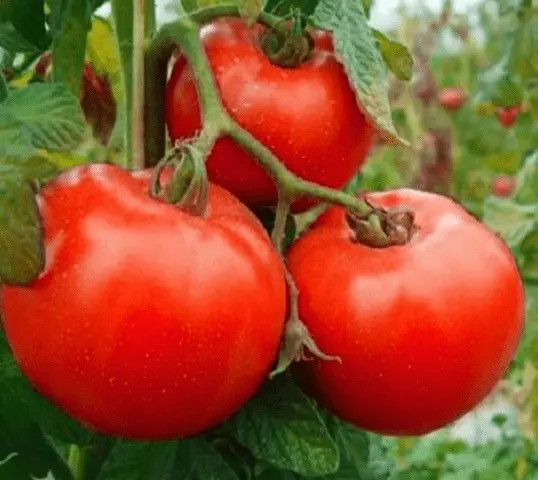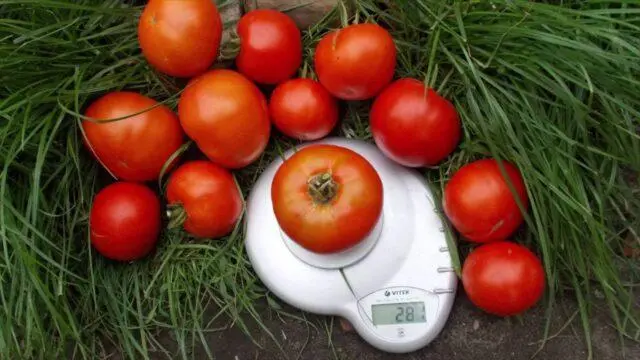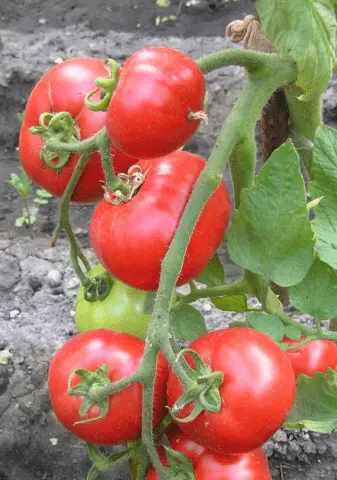Contents
Palace tomato is a high-yielding variety. It gives very large fruits, reaching 500-600 g in weight. The taste is excellent, the tomatoes are suitable for home-made preparations, fresh consumption and in all kinds of dishes. The variety has a fast ripening time. Fruits reach technical ripeness in 3-3,5 months after mass shoots.
History of breeding
Palace tomato is a variety bred by breeders Nastenko N.V., Gulkin M.N. and Kachaynik V.G. The applicant for inclusion in the register and the originator is the Aelita agricultural firm (Our Country, Moscow). The variety was successfully tested, and was included in the register of breeding achievements of the Federation in 2013.
Approved for cultivation in most regions:
- the middle lane, including the Moscow region;
- Northwest;
- the Volga region;
- Chernozem region;
- southern territories;
- The Urals;
- Western and Eastern Siberia;
- Far East.
Description of the variety of tomato Palace
Palace tomato variety is represented by an indeterminate bush that grows throughout the season. Plant height is small – up to 120 cm in a greenhouse and up to 100 cm in open ground. The leaves are medium in size, typical green in color. The stalk has no articulation, inflorescences of an intermediate type. The first brush is laid above 7-8 sheets, the next ones alternate after 2-3 sheets.
The fruits of the Palace tomato are flat-round in shape, with a noticeable ribbing. Coloring at the stage of technical ripeness is light green, there is a greenish spot at the base. Mature fruits are bright red in color. The size is large, by weight on average 350-400 g, individual specimens reach 600 g. There are six nests with seeds on the cut of the tomato. They can be collected and fertile offspring can be grown, since the Palace tomato is a variety, not a hybrid.

Tomatoes are large, with good taste
The pulp is juicy, medium density. In terms of ripening, the tomato belongs to the early ripening (early) varieties. It takes 90-100 days from the moment of emergence of seedlings to the stage of technical ripeness. Tomatoes of the Palace variety have time to ripen on the vine, so they can not be plucked for ripening. The main wave of fruiting occurs in July.
Characteristics of tomato Palace
The variety is distinguished not only by good taste, but also by very fast maturation. In addition, Palace tomato is characterized by a consistently high yield. Thanks to this culture, many summer residents appreciate it.
Productivity of tomato Palace
The yield of the variety is very high – 13-14 kg per square meter. This indicator can be achieved when grown in film shelters in compliance with the basic rules of agricultural technology, as well as with a fairly dense planting (4 bushes per 1 m2). If grown in open beds, the yield of the Palace variety can reach 10-11 kg, depending on weather conditions and care.
Disease and pest resistance
The variety has good resistance to major diseases and pests of tomatoes. To obtain a high yield, it is necessary to carry out preventive treatments with drugs, as well as periodically inspect the bushes for the presence of insects and other pests.
Application area
Palace tomatoes are very large and have a good taste. Therefore, they are mainly used fresh, as well as in preparations (lecho, vegetable caviar, homemade ketchup and others). For whole-fruit canning, such tomatoes are not suitable.
Advantages and disadvantages
Variety Palace gives large tomatoes, at the same time they ripen very quickly. The bushes are low, caring for them is quite simple. Therefore, both experienced gardeners and novice amateurs will be able to cope with growing.

Variety Palace is distinguished by large fruits and high yields.
Pros:
- good taste;
- immunity;
- can be grown in most regions;
- short maturation time;
- you can not buy seeds, but collect them yourself.
Cons:
- the maximum yield can only be achieved in greenhouses;
- not suitable for whole-fruit canning;
- bushes need a garter.
Peculiarities of growing
Palace tomato is classified as an early ripe variety, so seeds can be grown in early April, no later than the 15th. At the same time, in the south, sowing begins at the end of March, or they immediately plan to plant in open ground in early May.
Rules for growing tomato seedlings Palace standard:
- Make soil from garden soil, humus, peat and sand (2: 1: 1: 1).
- Divide it into containers.
- Plant the seeds to a depth of 1 cm with an interval of 2-3 cm.
- Spray from a spray bottle.
- Cover with a film with holes and put in a warm place.
- Grow at a temperature of 25-27 degrees.
- After germination, remove the film.
- After the formation of 3-4 leaves dive.
- Two weeks before transplanting into the ground, start hardening outdoors.
Palace tomato seedlings are transferred to the greenhouse no earlier than mid-May, when the threat of return frosts will be minimized. 3-4 plants are planted per square meter, adhering to the 60 * 40 cm pattern. Immediately after planting, they are watered, sawdust, wood chips or other mulch are laid.
When growing Palace tomatoes, you must follow the standard rules:
- Water 2-3 times a week with settled water. In this case, you need to ensure that the surface layer of the soil is not too wet.
- Fertilize every 10-15 days. It is advisable to alternate organics (potassium humate, infusion of freshly cut grass, liquid mullein) with complex mineral supplements.
- Tie the bushes in the first days after planting.
- Lead in 1-2 trunks.
- Ventilate the greenhouse periodically, especially on hot days.
Pest and disease control
Palace tomatoes rarely suffer from diseases and pests. But for this they need to provide good care, as well as follow certain preventive measures:
- tomatoes are not planted in beds where solanaceous (potatoes, peppers) have recently grown;
- seedlings are treated with fungicides before being placed in the ground;
- do not exceed the watering rate;
- after harvesting, carefully dig out and remove all tops.
To combat late blight, powdery mildew and other fungal infections, preventive treatments with fungicides are carried out, for example:
- “Fitosporin”;
- “RAW”;
- “Abiga Peak”;
- “Ridomil Gold”;
- “Fundazol” and others.

To get a good harvest, the bushes must be treated with drugs for prevention.
Also, during the period of growth and fruiting, Palace tomatoes should be sprayed from aphids, spider mites and other pests. To do this, use insecticides:
- “Fitoverm”;
- “Aktara”;
- “Confidor”;
- “Decis” and others.
It is desirable to carry out processing in the late evening, and the weather should be calm and without rain.
During fruiting, Palace tomatoes are best treated with folk remedies, for example, infusion of wood ash, tobacco dust, decoction of potato tops, infusion of chili peppers and other compounds.
Conclusion
Palace tomato is a rather interesting variety that is suitable for growing in almost all regions. Productivity is high, especially when cultivated in greenhouses and under film shelters. Care is simple, includes watering, top dressing. Bushes must be tied up, otherwise they will not withstand the weight of large tomatoes.









